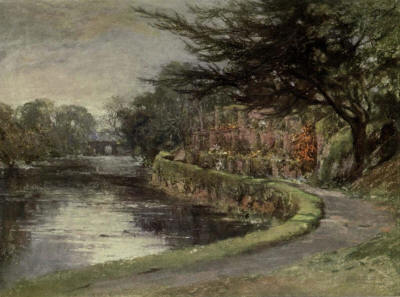|
 O
one can realise, until he tries it, the difficulty of making a small
selection from the many beautiful gardens to be found in every Scottish
county. There are famous gardens, such as those at Dalkeith, Drumlanrig,
Preston Hall, Drummond Castle, Terregles, and many other places, to
which we would fain have given a place in these pages, had they not been
described and depicted in so many previous publications. Our purpose has
been, not to present the well-known and distinguished, but rather to
point out in how many gardens, humble as well as lordly, beauty is to be
found by anybody who cares to look for it. O
one can realise, until he tries it, the difficulty of making a small
selection from the many beautiful gardens to be found in every Scottish
county. There are famous gardens, such as those at Dalkeith, Drumlanrig,
Preston Hall, Drummond Castle, Terregles, and many other places, to
which we would fain have given a place in these pages, had they not been
described and depicted in so many previous publications. Our purpose has
been, not to present the well-known and distinguished, but rather to
point out in how many gardens, humble as well as lordly, beauty is to be
found by anybody who cares to look for it.
Many charming homes have
been built and many delightful pleasure grounds laid out in the
immediate neighbourhood of
"Auld Ayr, wham ne'er a
town surpasses
For honest men and bonny lasses,"
but there is no garden in
that district to be compared with that of Auchencruive for natural charm
of rock and river, sequestered glades and shaggy cliffs. There are
gardens elsewhere more noteworthy than this one for their contents—for
extensive collections of exotics or remarkable specimens of individual
species. It cannot be denied that the owners of Auchencruive, past and
present, have displayed little ambition in these respects, and this the
enthusiast may feel inclined to regret, for undoubtedly there are the
means here, on a friable soil in a western climate, with abundant
shelter from violent winds, of cultivating the choicer kinds of trees
and shrubs mentioned in Appendices A and B.
Nevertheless, natural
features have not been neglected ; breadth of effect has been well
secured by contrast of massive woodland with liberal spaces of turf;
brightness has been obtained by beds of roses and the ordinary border
flowers ; and through this fair scene flows the river Ayr, here churning
into foam among reefs of red sandstone, there sweeping in glassy reaches
under the shade of venerable trees.
Miss Wilson has chosen
for her subject the cliff which falls sheer from the bluff whereon the
mansion-house is built, and which has been skilfully wrought into a
banging garden in a series of galleries rather than terraces. It is a
notable feature, and confers an air of distinction upon what might
otherwise be remembered as merely a very pretty garden. Sameness is not
so prevalent a vice in decorative horticulture as it was five-and-twenty
years ago. It is the

exception now to meet
with a lady presiding over a country house who feels indifferent to the
contents of her flower-beds. Most ladies, and many men, now take an
active interest in cultivating a variety of flowering things. Disraeli
had a hand in turning the attention of people of leisure to this source
of enjoyment and perennial occupation. Probably no subject of Queen
Victoria was more ignorant of the processes of horticulture. Had he been
asked the definition of a herbaceous plant he would have found refuge in
an epigram. But he had the saving grace of imagination which enabled him
to perceive that beds of "Mrs. Pollock" geranium and "Countess of Stair"
ageratum were no more capable than a Brussels carpet of inspiring
affection. Pereunt et non imputantur. They carry with them no
associations—are redolent with no tender memories. Therefore, desiring
to depict Corisande as devoted to her flowers, Disraeli filled her
garden with old-world perennials—plants more abiding than the
generations of men, yielding blossoms year by year to the children's
children of those who set them in the borders. And, when Disraeli had
stirred people's fancy with a longing for the old flowers that they
could love, Mr. William Robinson began to teach them how that longing
might be realised, and he has lived to see the revolution complete.
There is an end to
sameness in gardens, but the risk of tameness is as great as ever. A
dominant feature, like the flowery cliff at Auchencruive, preserves a
garden from the one defect as much as from the other. I remember the
Auchencruive garden thirty years ago when sameness and tameness were at
their height, and that cliff stands out in memory, wreathed with bright
flowers, the broad river at its foot sparkling in the sunlight and
glimmering in green gloom of old oaks on the further shore.
At Auchencruive one is in
the very heart of what railway companies and hotel managers never weary
of proclaiming as the Land of Burns. Very characteristic of the vates
lacer, though hardly creditable to his sense of delicacy, are the verses
in which two successive mistresses of the house of Auchencruive are
commemorated. The first of these was wife of that Richard Oswald whom
Shelburne appointed in 1782 as Minister-Plenipotentiary to negotiate the
treaty with the United States. Burns never met her living, but in
January, 1789, when riding through Nithsdale, he stopped for the night
at Sanquhar.
"The frost was keen," he
wrote to Dr. Moore, "and the grim evening and howling wind were ushering
in a night of snow and drift. My horse and I were both much fatigued
with the labours of the day; and just as my friend the bailie [Whigham]
and I were bidding defiance to the storm over a smoking bowl, in wheels
the funeral pageantry of the late Mrs Oswald; and poor I am forced to
brave all the terrors of the tempestuous night, and jade my horse—my
young favourite horse whom I had just christened Pegasus—further on,
through the wildest hills and moors of Ayrshire, to New Cumnock, the
next inn! The powers of poesy and prose sink under me when I would
describe what I felt. Suffice it to say that, when a good fire at New
Cumnock had so far recovered my frozen sinews, I sat down and wrote the
enclosed ode."
Dr. Moore had done well
for his friend if he had suppressed the said ode, for slander grosser
and more gratuitous was never penned than this lampoon upon a lady, who,
during her life, had never given the writer cause of offence.
Nevertheless, his case was a bard one; he did but express in stinging
verse the irritation which one of us lesser mortals would have vented in
bad language.
The other composition was
of a very different character, and, in its later form, celebrated the
charms of the wife of the first lady's grandson, M.P. for Ayrshire. Her
name was Louisa, which, for the sake of metre, was altered to Lucy in
the poem. The husband is supposed to be singing the praises of his wife.
"O, wat ye wha's in you
town,
Ye see the e'enin' sun upon?
The fairest dame's in you town
That e'enin' sun is shining on."
Such is the refrain of
eight fervent stanzas; but woe's me for Robin's constancy! The verses
were originally addressed to Jean Armour—the "bonnie Jean " of many an
ode. To adapt them to another fair one's acceptance, "maid" had to be
altered to "dame," and "Jeannie" to "Lucy!" Conscientious editors have
duly chronicled in footnotes the variant readings. |
